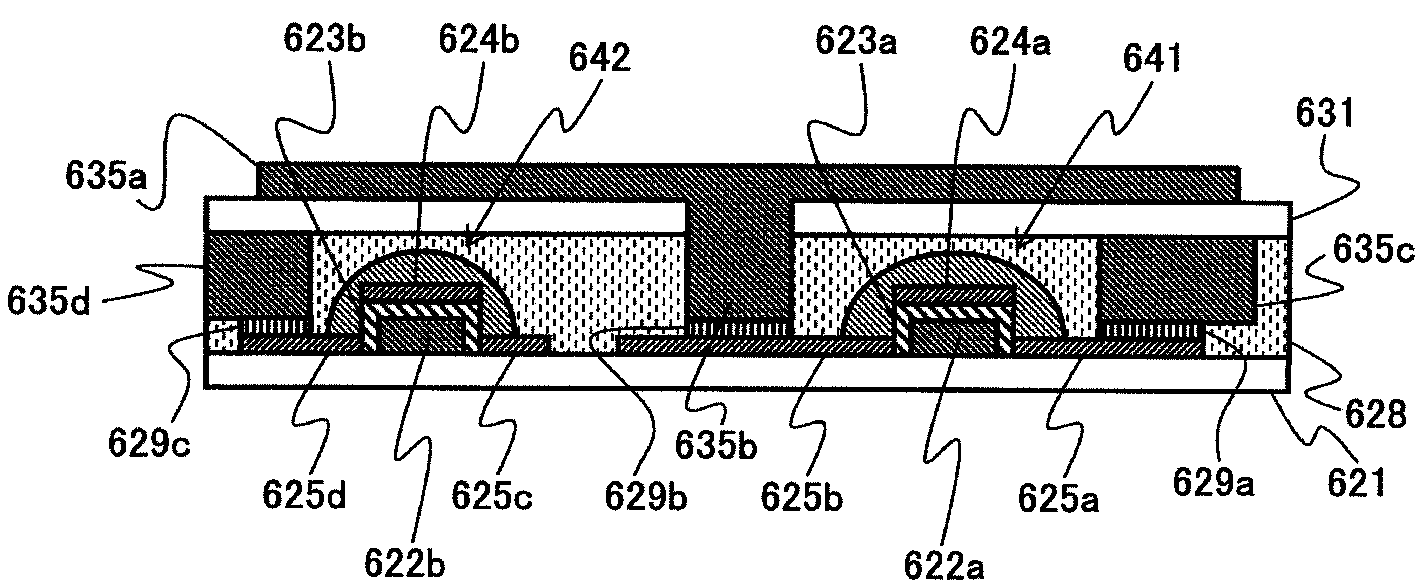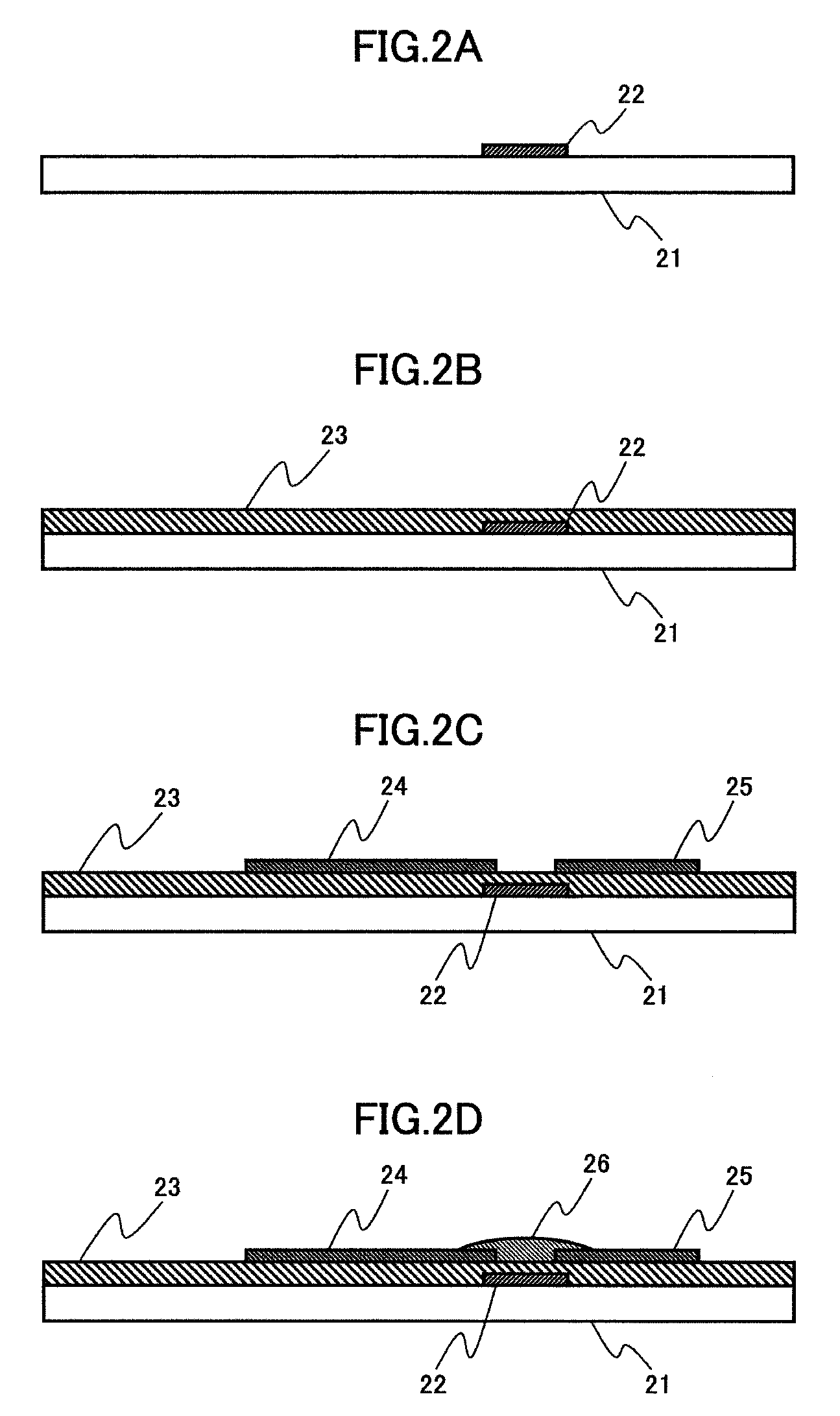Display device and manufacturing method of display device
a technology of display device and manufacturing method, which is applied in the field of display device, can solve the problems of difficult to obtain sufficient characteristics, a number of processes for processing, and damage to organic semiconductor materials
- Summary
- Abstract
- Description
- Claims
- Application Information
AI Technical Summary
Benefits of technology
Problems solved by technology
Method used
Image
Examples
first embodiment
[0042]the invention will be described. This embodiment relates to a method of manufacturing an electrophoretic display device. FIG. 1 shows the composition of a drive circuit of the electrophoretic display device of this embodiment.
[0043]Specifically, as shown in FIG. 1, a FET (field effect transistor) 12 and a pixel capacitor 13 are arranged for every pixel of the display device to drive an image displaying element 11 which is an electrophoretic display element used as one pixel.
[0044]In the FET 12, the gate (G) is connected to a gate line 15, the source (S) is connected to a signal line 14, and the drain (D) is connected to both one electrode of the image displaying element 11 and one electrode of the pixel capacitor 13. Both the other electrode of the image displaying element 11 and the other electrode of the pixel capacitor 13 are grounded.
[0045]In the drive circuit, the voltage supplied from the signal line 14 according to the gray scale of each pixel, and the gate voltage from...
second embodiment
[0084]Next, the invention will be described. This embodiment relates to a method of manufacturing an electrophoretic display device. The composition of a drive circuit for driving the electrophoretic display device of this embodiment is shown in FIG. 7.
[0085]Specifically, as shown in FIG. 7, the drive circuit of this embodiment is a drive circuit which supplies current to a current drive type display element to drive the display element. To drive the display element 111 which is an electrophoretic display element used as one pixel, two FETs (field effect transistors) 112 and 113, and a pixel capacitor 114 are formed for every pixel.
[0086]In the FET 112, the gate (G) is connected to the gate line 115, the source (S) is connected to the signal line 117, and the drain (D) is connected to both the gate (G) of the FET 113 and the electrode of the pixel capacitor 114. The electrode of another side of the pixel capacitor 114 is connected to the capacitor line 116.
[0087]In the FET 113, the ...
fourth embodiment
[0159]Next, the invention will be described.
[0160]The fourth embodiment is formation method with another electrode of the second substrate 31 and 131 about the first embodiment and second embodiment, and explains the case where an electrode is formed in what serves as the second substrate 131 of the second embodiment concretely.
[0161]First, as shown in FIG. 17A, contact hole 332 is formed in the second substrate 331. The formation method is the same as that of the first embodiment and the second embodiment.
[0162]Next, as shown in FIG. 17B, resist pattern 333 is formed in the region in which the electrode of both sides of the second substrate 331 is not formed. After applying resist to both sides of the second substrate 331, specifically, resist pattern 333 is formed by performing prebaking, exposure by the exposing device, and development.
[0163]As for this resist pattern, it is desirable to form more thickly than the thickness of the electrode formed behind. It is possible to form t...
PUM
| Property | Measurement | Unit |
|---|---|---|
| anisotropic | aaaaa | aaaaa |
| anisotropic conduction | aaaaa | aaaaa |
| semiconductor | aaaaa | aaaaa |
Abstract
Description
Claims
Application Information
 Login to View More
Login to View More - R&D
- Intellectual Property
- Life Sciences
- Materials
- Tech Scout
- Unparalleled Data Quality
- Higher Quality Content
- 60% Fewer Hallucinations
Browse by: Latest US Patents, China's latest patents, Technical Efficacy Thesaurus, Application Domain, Technology Topic, Popular Technical Reports.
© 2025 PatSnap. All rights reserved.Legal|Privacy policy|Modern Slavery Act Transparency Statement|Sitemap|About US| Contact US: help@patsnap.com



